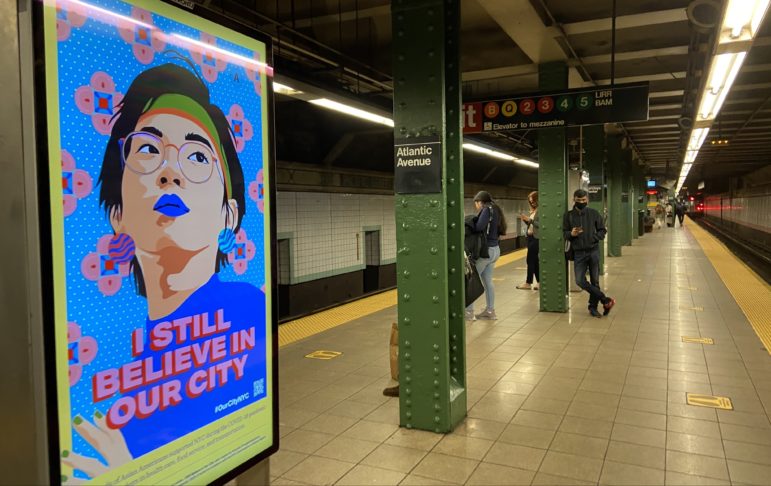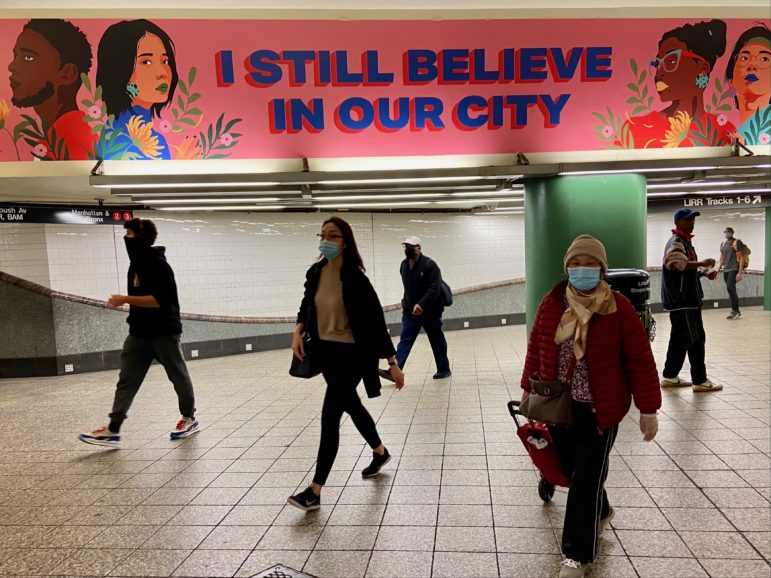From the start of the city’s coronavirus crisis in February 2020, the city’s Commission on Human Rights received more than 566 reports of discrimination, harassment, and bias related to COVID-19, 184 of which were anti-Asian in nature.

Nicole Javorsky
A new public art campaign by the city celebrates Asian and Pacific Islander (API) New Yorkers and expresses solidarity with the Black Lives Matter movement.
Nine subway lines and LIRR service intersect at Atlantic Terminal near Brooklyn’s Barclays Center, making it a connection point for New Yorkers of all backgrounds: more than 14 million passengers passed through the station last year.
That’s why the city chose the terminal to house a new public art campaign, “I Still Believe in Our City,” that celebrates Asian and Pacific Islander (API) New Yorkers and expresses solidarity with the Black Lives Matter movement. The NYC Commission on Human Rights and Amanda Phingbodhipakkiya, one of the commission’s two 2020-2021 Public Artists in Residence (PAIR), launched the campaign in part to combat the uptick in bias incidents related to the COVID-19 pandemic.
“The insidious nature of white supremacy is that it pits communities of color against each other,” Phingbodhipakkiya said at Atlantic Terminal on Friday, surrounded by her larger-than-life-sized artworks on the station walls. “This [campaign] is saying we can stand for each other. I want people to look at these faces and feel us reclaiming space.”

Nicole Javorsky
From the start of the city’s coronavirus crisis in February 2020, the city’s Commission on Human Rights received more than 566 reports of discrimination, harassment, and bias related to COVID-19, 184 of which were anti-Asian in nature. Last year, by contrast, the Commission received just 26 reports of anti-Asian discrimination over the same time period.
“Asians are the fastest growing ethnic group in America, and yet, we are told to ‘go back,’ and that we don’t belong,” said Rocky Chin, Commissioner for the NYC Commission on Human Rights, in a press release. “Amanda’s artworks show the world that this is our home, and displays Asian New Yorkers proudly defying harmful stereotypes.”
The installation, which began on Nov. 3 and will remain on display through Dec. 2, includes 45 of Phingbodhipakkiya’s works, which feature vibrant colors, symbolic images, and faces which the artist describes as “defiant, hopeful, and strong.” She noted that the flowers that surround the figures each have a deeper symbolism in Chinese culture: “Chrysanthemum signifies resilience, Peony signifies friendship and solidarity, and Hawthorn berry signifies longevity and protection.”

Nicole Javorsky
Phingbodhipakkiya said that growing up in Georgia, she’d experienced many moments of anti-Asian bias, including at school. She moved to New York for college in 2006, and described the move as her “seeking refuge in a diverse place that welcomed people from all walks of life.” The art campaign is Phingbodhipakkiya’s way of expressing hope and encouraging everyone to stand up for each other. As the text on one of her artworks reads in peach-colored capitalized letters, “WE CAN DO MORE.”
Phingbodhipakkiya says she also hopes that seeing the works in the art campaign will invite folks to speak up more and talk about experiences with discrimination, bias, or harassment.
“It’s common in the Asian American community to bury the hurt deep inside. That’s typical also of the immigrant experience in America,” she adds. “Talking about these hurtful and harmful experiences is just as an important part as talking about the resilience of communities. And, sometimes resilience comes from sparking joy.”
The campaign will also be featured at the city’s LinkNYC kiosks and bus shelters, starting in December, as well as a future installation in partnership with the NYC Department of Transportation’s Art Program. There are also plans for a community mural, potentially sometime in the spring.

Nicole Javorsky
Nicole Javorsky is a Report for America corps member.









6 thoughts on “Subway Art Campaign Tackles Anti-Asian Bias During COVID-19”
I guess Asian men are not marketable as women in America’s white patriarchal society. Or they don’t threaten the status quo as much.
Why not an Asian American family? Why three individuals all of them being women? Each separate yet presented as one in a unified color scheme and ornamental flat patterns together with white and mostly yellow flowers. The eyes aware of observers midst a sense of a pleasant norm of beauty. Free of text. Others where the text is front and center. Together these displays have a subtle stance that doesn’t address directly behaviors inimical to Asian people. Rather they address us all as subway commuters, our civic expectations on how we live and behave in a public space, thus the phrase ‘our City’. Will this kind of display effect a greater sense of awareness? Will it nurture a sense of kindness, of curtesy towards Asian people and counter random moments of fears or anxiety or absent mindedness midst the haste and bustle of our city’s public spaces?
Agree with Robert Lee. Would be nice to add an Asian family instead of individuals.
Phingbodhipakkiya. You had 3 opportunities to include an Asian guy or traditional Asian family but chose not to and instead put random Black people in a campaign that seems targeted at reducing anti-Asian violence. Are you trying to say it’s ok to attack Asian guys? And how dedicated are you or this article’s photographer or team to excluding Asian guys as even the last picture in the article seems to be taken at an opportune time where only a young and old AF can be seen.
Asian Pacific Islander, expresses solidarity with BLM (communist socialist). We’re all human beings on this planet. I wonder if the art is paid for by billionaire George Soros (a Natzi collaborater, who pays for propaganda), to incite people fighting each other. Fake news about the corona virus too. There’s more people dying from suicide and starvation the cold virus
*Then the corona virus